“Recycling—From Stars to Starships” by Jim Beall
Stars recycle and so must we if we are to travel between them.
 |
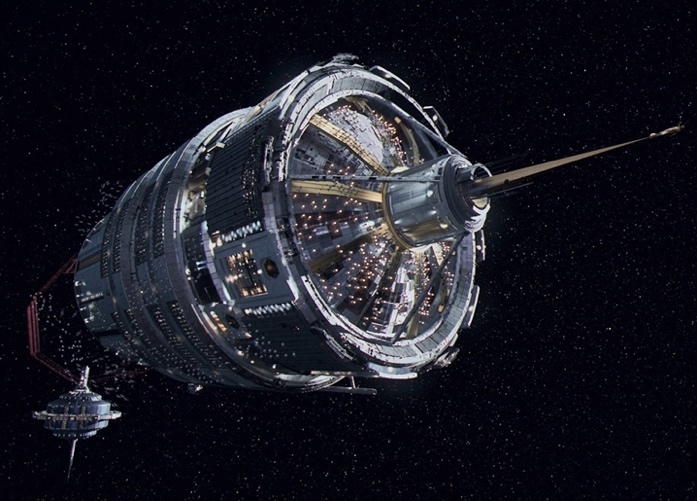 |
| Supernova Remnant Cassiopeia A | Nauvoo Generational Starship |
| Image credit: NASA/CXC/SAO | Image credit: expanse.wikia.com |
Stars have practiced recycling from near the beginning
The ordinary matter of the early universe was mostly hydrogen with some helium. Population III stars formed out of that primordial mix (with trace amounts of lithium and beryllium) and fused more hydrogen into helium. Those stars had comparatively short lifespans ending in supernovas (or other stellar events such as becoming black holes) and spreading heavier elements into space where they—along with hydrogen—became part of Population II stars. (NOTE 1)
Science fiction author Larry Niven introduced an alien species ("Outsiders") in his short story "Flatlander" (1967) who were helium II beings, perhaps dating back to those first populations of stars.
When that next generation of stars ended with supernovas (or other stellar events) of their own, still heavier elements were ejected into space. The Sun is a Population I star. That is, based on spectral analysis, some of the elements contained within its mass have been recycled from at least two previous stars.
Novas and supernovas have long been a staple of science fiction, especially weapons that can cause them, whether it be nova bombs (Andromeda), trilithium torpedoes (Star Trek), or even weaponized gravitational drives (The Armageddon Inheritance, 1993, by David Weber). Sometimes the solar event is inadvertent, such as in "Time Fuze" (1954, by Randall Garret) where Earth's first starship learns to their dismay that their FTL drive causes nearby stars to nova (including the Sun, as they discover at story end). In another short story, "The Fourth Profession" (1971, by Larry Niven), a visiting merchant race needs humans to build space laser cannons to propel their light sails to let them to proceed to their next stop but, if deals cannot be reached, they have a nova device to use instead.

The Armageddon Inheritance, by David Weber
The Earth has apparently always recycled its crust
Recycling is not limited to stars. The Earth recycles its crust, and apparently always has. The ratios of certain elements (e.g., germanium and silicon) in samples taken from the basalt deposits of mid-oceanic ridges all over the world indicate that crust material remelted by subduction spreads evenly throughout the mantle and must have been doing so throughout most of the planet's history. (NOTE 2)
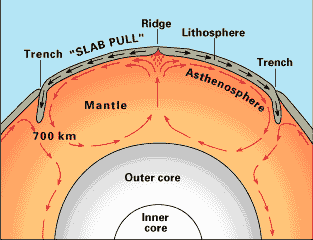
Mantle Recycling
Source: United States Geological Service—Public Domain
The recycling mechanism—subduction—is part of plate tectonics (originally called "continental drift"), which was itself considered fiction or even fantasy by most authorities. Abraham Ortelius (NOTE 3) and other early cartographers, as well as explorers such as Magellan, had noted that sections of continents appeared to line up with others. The edge geologies appeared to match, and paleontologists also identified similarities in the fossil records. Nonetheless, when Alfred Wegener formally proposed continental drift in his 1915 paper, Die Entstehung der Kontinente und Ozeane (The Origin of Continents and Oceans), many authorities summarily rejected it due to the absence of any known "force that could move continents." (NOTE 4)
By the mid 1960s, the discovery and validation of seafloor spreading led to widespread acceptance of plate tectonics by the geoscientific community.
Science fiction and fantasy stories have long featured plots and characters with vulcanism and earthquake elements and abilities, respectively. Plate tectonics soon became another such world-building and plot element. Hardly a decade after the official recognition of plate tectonics, Larry Niven's Protector (1974) had the last "protectors" on their abandoned homeworld induce plate tectonic and other planetary disturbances to make their planet's interior metals accessible for the construction of their space fleet.

Protector, by Larry Niven
Image credit: Wikipedia
In David Brin's Startide Rising and Uplift War (1983 and 1987), planets are allowed to "go fallow" and renew their entire ecosystems and surfaces (via tectonic plate subduction and other mechanisms) to facilitate the possible rise of new species that could be uplifted to sentience. More recently, the Broken Earth trilogy by N. K. Jemisin used "geoscience fiction" and plate tectonics throughout as a central theme of the entire series. The world is subject to periods of geologic instability, and the central characters are those with genetically-engineered abilities to affect those forces.
Humans have always recycled
Whether fashioning huts with reeds or crafting tools out of stone or bone, humans have always practiced recycling. This practice included reusing the building materials of the great majority of the structures of antiquity. Those exceptions that did survive did so for a variety of reasons. The Pantheon (Rome), for example, has been in continuous use since construction nearly two millennia ago. (NOTE 5) Some, such as Machu Picchu (Peru), were in locations sufficiently inconvenient or remote as to discourage efforts to reuse their materials. Others, like Palenque (also called "Lakamha," Mexico) were abandoned and their sites largely reclaimed by nature.

Palenque, Mexico
Image Credit: G. Mannaerts—Wikimedia Commons
Many such ancient sites were "rediscovered" by Western adventurers and archaeologists within the last century or so (NOTE 6). Science fiction has long had as a meme the discovery and exploration of the ruins of ancient, advanced civilizations. Perhaps the earliest example was the 1827 novel by Jane Wells Webb, The Mummy! (NOTE 7) The fictional adventures of "Indiana Jones" and "Lara Croft" ("Tomb Raider") have continued that practice.
One of the author's science fiction favorites that features exploring a long dead civilization is Galactic Derelict (1959, by Andre Norton), in which characters inadvertently activate a spaceship that takes them on an involuntary grand tour of ancient sites. Another particularly notable example that involves exploring a long-abandoned site of a still existing and advanced race is Frederick Pohl's Gateway (1977). (NOTE 8)


Image Credits: Wikipedia
More recently, the movie and television series "Star Gate" featured current day characters who activate ancient abandoned technology only to find that the builders are still quite active.
Other buildings from antiquity have survived only in part. That is, what remains today are the materials least valuable, accessible, or portable. The most prominent examples of this are the pyramids of Giza (Egypt). It is instructive to note that they were originally smoothly surfaced with huge, incredibly engineered, hand-polished casing stones of white limestone. The number of man hours required for this one sub-task has been estimated to be in the millions. (NOTE 9). As originally constructed, they must have seemed to glow as they dominated the horizon for miles in all directions.
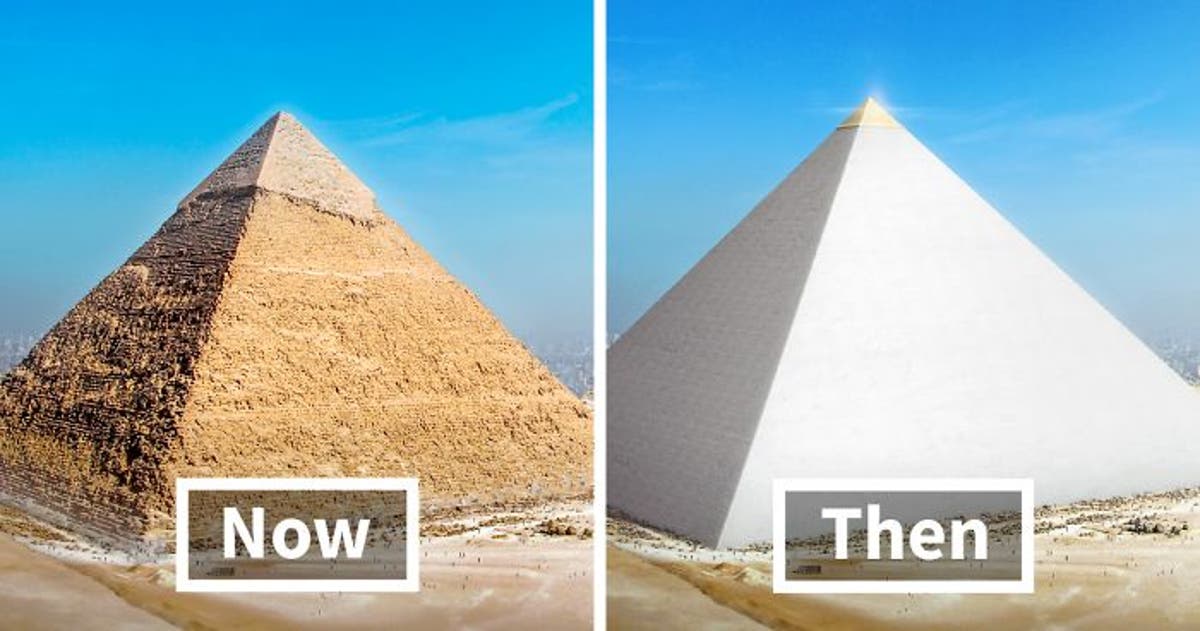
The Great Pyramid of Giza
Image Credit: Budget Direct (NOTE 10)
The Great Pyramid of Giza (aka, the Pyramid of Khufu or the Pyramid of Cheops) remained essentially externally intact until the great 1303 Crete earthquake shook some casing stones free and opened cracks allowing tools easier prying access. By 1356, many of the casing stones had already been recycled into structures in nearby Cairo. See the image below of one of the surviving casing stones.
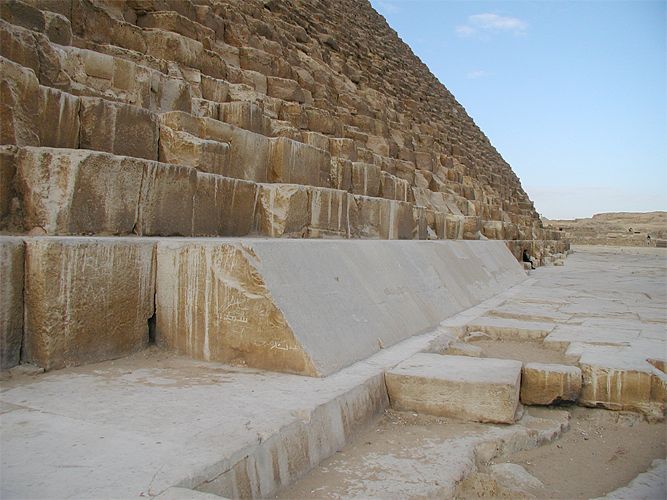 |
 |
| Jon Bodsworth, Copyrighted free use | Same casing stone, circa 1912 |
| Wikimedia Commons | Public Domain |
High quality stone was also a valuable resource for more than reuse in new buildings. For example, consider the anchor below:

3,400-year-old Egyptian anchor on display at the Israel Museum
(Photograph credit: Laura Lachman)
The decoration on the anchor depicts a woman writing on a tablet. The symbol above her head identifies her as the goddess Seshat, the ancient Egyptian deity of writing, and the hieroglyphs contain the traditional divine attribute: “Mistress of the house of books.” The style and hieroglyphs indicate that the beautiful, polished limestone slab would have adorned the wall of a major Egyptian shrine during the Late Bronze Age, roughly 3,400 years ago, before it began its "second career" as a boat anchor. (NOTE 11)
Most of the pyramids' structures remain available for viewing and study, but the recycling of buildings has long posed challenges for archaeologists because the process makes historic sites effectively "vanish." Overhead photographs from aircraft and, more recently, drones have proved immensely helpful in finding such "lost" structures. The soil in fields is shallower over residual foundations than normal, but deeper than normal over trenches, pits, and dug out buildings. These differences are plainly visible, especially during periods of drought.
The resulting variations in vegetation growth produce ghostly blueprints of the buildings themselves, complete with interior wall lines. Below is an overhead photograph from a typical location, and a sketch depicting the process.

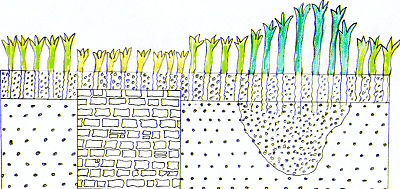
Images source: Wikipedia
In effect, the markings on the ground reveal the extent of the recycling. If the stones or bricks in the wall (or road) were removed but the foundation or bottom courses left in place, then the shallow soil yields lower growth of vegetation (pale strips or lines). If all the stones were dug out, then greater soil depth allows greener or thicker plant growth than normal. In the first image above, the light stretch on the left marks the road, whose rocky subsurface remains under the grass. The thinner pale lines on the right show were walls once stood but their foundations remain, revealing in the shorter grass a virtual blueprint of the building that was there.
Finding and investigating these patterns have led to numerous archaeological finds over the last few decades. In some cases, onsite investigations have revised the understanding of local history. Many other excavations have revealed that sites were reused period after period, such as a known Iron Age site having been previously occupied in the Bronze Age, and perhaps even in the Neolithic. The long running British Time Team television program (NOTE 12) documented hundreds of such cases during their real-time digs. (NOTE 13) In each such case, it is the site itself that was recycled.
As noted previously, humans have generally recycled everything that they conveniently or profitably could. (NOTE 14) In fact, declining to recycle has been a luxury, including deliberately preserving sites on cultural or historical grounds. A new motivation has emerged to encourage preservation: tourism. Ecotourism is a rising revenue source world-wide, but archaeological tourism is centuries old (NOTE 15) and continues to grow strongly. Greece, with all its preserved temples and monuments, derives about one-fourth of its annual gross domestic product (GDP) from tourism. Egypt gained about eleven percent GDP from archaeological tourism while employing about fourteen percent of its population from tourism, until terrorist attacks on foreigners began greatly reducing the numbers of visitors.
Perhaps an even better indicator of the expansion of archaeological tourism—and its associated economic boons—is that remote and difficult to access Machu Picchu drew over one and a half million visitors in 2018. In that same year, partially cleared Palenque had nearly three-quarters of a million visitors, and the total for all archaeological sites administered by Mexico's Instituto Nacional de Antropología e Historia was nearly seventeen million. Meanwhile, the number for Angkor Wat was over two and a half million.
The process of recycling large blocks of stone includes demolishing, digging, and transporting. Re-users would only choose to do it if they did not have a better option. This was usually an easy economic decision when a new structure replaced the old on the same site, but many times this was not the case yet recycling was done anyway. Quarrying hard rock with only hand tools simply required so much labor that suitable existing stones were still worth the effort even if their next intended use was a considerable distance away.
Quarrying is also slow and, even with recycling, would be challenged to support a prosperous growing civilization. The need for structural materials naturally increases with human population and their standard of living. Thus, successful and expanding human polities have always consumed progressively greater amounts of whatever was used for buildings, with higher status portions of their societies demanding more and better prestigious construction elements.
This brings us to Rome, and concrete.
Romans were not the first to invent concrete (NOTE 16) but their empire grew to such a large size in area, population, and urbanization that neither harvesting wood nor simply quarrying stone would have sufficed to meet their needs. Roman engineers turned to concrete as the key building material, including for elite structures like the Pantheon, the Coliseum, and major aqueducts.
Recovering large stones allows their reuse in high quality structures, but attempts to recycle concrete (especially with lower tech tools) generally result in rubble adequate only for prosaic applications such as fill or road beds. This, perhaps serendipitously, is one of the major reasons why many historic Roman structures have survived into the present day. That is, they would have been expensive to demolish and would have yielded little in the way of valuable material.
Two of the key elements were recycling volcanic ash (e.g., Pompey and Vesuvius) and high temperature kilns (~1700 degrees Fahrenheit). (NOTE 17) When Rome fell, the making of concrete was among the many scientific and engineering "secrets" that were lost. (NOTE 18) Over a millennium would pass before a process to make satisfactory concrete would be rediscovered. (NOTE 19)
If science fiction authors want an easy way to create a major alternate history, all they need do is postulate an earlier rediscovery of how to make concrete. Historically, manuscripts by the Roman Pollio Vitruvius (who died circa 15 AD) that contained a section on Roman cement manufacturing were rediscovered in 1414. They would be translated and republished around 1450, and gradually spread across Europe. This revived the interest in concrete and Fra Giocondo would use Roman style cement to build the pier of the Pont de Notre Dame in Paris in 1499, the first modern use of concrete. Those same Roman manuscripts could easily have been retranslated centuries earlier than historical, as several dozens of other copies survived the fall of Rome and still existed throughout the Dark Ages.
One more aspect of concrete is worth noting. Where Romans used volcanic ash, modern concrete makers have commonly used coal power plant fly ash. This allows coal plants to harmlessly recycle that waste product in an environmentally safe and useful way. The decreasing number of operating coal plants has posed a problem for the concrete industry.
Before turning to modern recycling, glass merits a special mention. Glass has a long history but is much easier to recycle (with low technology) than make from raw materials. For example, glass appears not to have been domestically produced in Britain until at least two centuries after the Romans left. (NOTE 20) However, archaeologists have found considerable amounts of Roman glass in Britain, along with sites where shards of Roman glass were remelted to make new objects. Given the relative fragility of the material, it appears likely that a significant fraction of all the glassware used in Roman Britain were made from recycled material.
Recycling is even more important today
Recycling remains an easy decision when there is profit to be made, with aluminum a leading example. Despite being the most common metal in the Earth's crust (eight percent), refining costs made it so rare that it was used as jewelry as late as the end of the 19th Century. Bulk use of aluminum appeared fantastical and, indeed, Jules Verne had an aluminum rocket in his 1865 Journey to the Moon.
When the U.S. Army Corp of Engineers needed a "perfect" material for the apex of the Washington Monument, the performance requirements and the desire to be impressively unique made aluminum by far the best choice. The nine-inch, 100 ounce pyramid casting was, in 1884, the largest piece of aluminum in the world. It would take Charles Martin Hall's revolutionary electrolysis refining process coupled with George Westinghouse's electrical harnessing of Niagara Falls to make aluminum practical for other uses. (NOTE 21)
Recycling aluminum takes about 8% of the energy required to mine and refine bauxite to make aluminum. With this sort of economic incentive, it should come as no surprise that nearly 75% of all the aluminum ever produced is still in use today. (NOTE 22)
The statistics are equally astounding for steel. According to the Steel Recycling Institute, steel "is the most recycled material on the planet, more than all other materials combined" with about 86% of steel being recycled. Yet, despite that level of success, the growth of planetary population and standards of living still requires about that one-third of all steel must be produced from raw materials. (NOTE 23)
Sometimes recycling is essential simply to deal with a durable product used in bulk and discarded in bulk. Vehicle tires may head this list. In this country alone, about one tire per person is discarded annually, or somewhat over 300 million per year. Despite some early recycling efforts, this led to enormous piles of tires building up all over the planet with the total number of discarded tires reaching about one BILLION in the United States in 1990, with perhaps an equal number in other countries around the world. (NOTE 24) Many sites covered so much area that they were visible from orbit. (NOTE 25)
Significant progress has been made in recycling tires. According to the EPA and the U.S. Tire Manufacturers Association (USTMA), over 80% of annually discarded tires now undergo recycling, 90% of those tire piles have been abated, and U.S. discarded tire inventories have been reduced from over one billion to perhaps seventy-five million. For example, one site in Colorado once had an estimated 80 million tires piled up and became known as "Tire Mountain." The picture below shows the "Tire Mountain" site after substantial reduction has taken place. The remaining tires are in cells of one million each separated by fire walls of sand and clay. Perhaps "Tire Prairie" is now a more appropriate name.
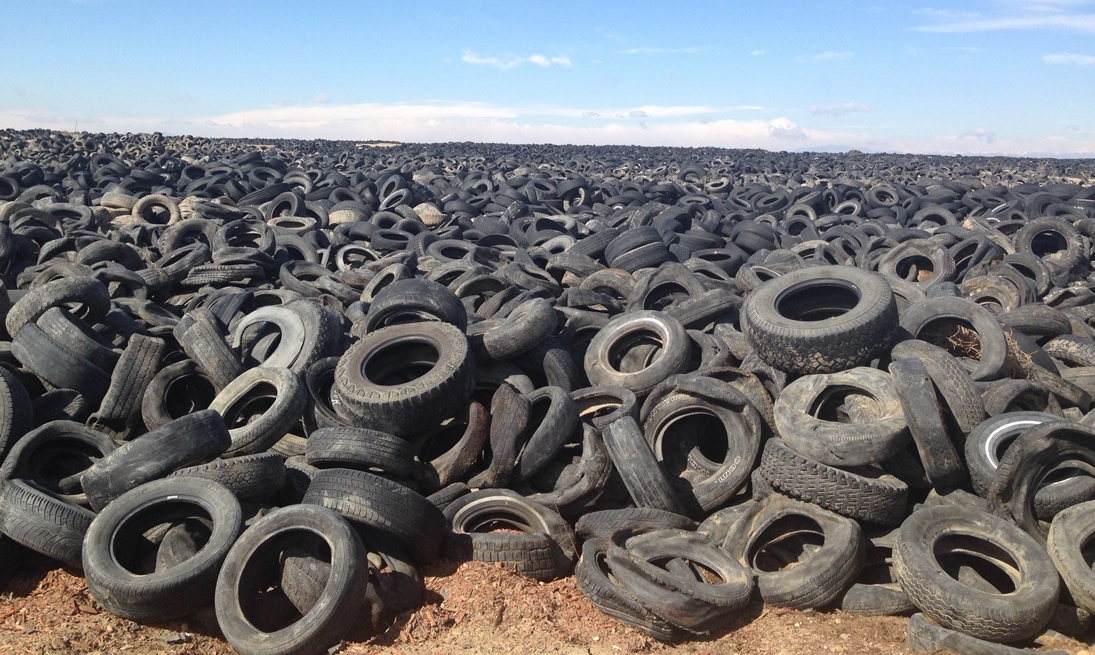
The remains of "Tire Mountain" in Colorado
Photograph courtesy of John Sheerin, USTMA (NOTE 26)
Tires are engineered not merely to survive adverse weather, repeated impacts, and extreme temperatures, but to perform well under those conditions. Thus, the better the tire, the tougher it is to recycle it. The absence of mechanical shredders sufficiently powerful to process tires in bulk delayed recycling efforts until a merging of three factors occurred. Environmental concerns helped drive research and focus regulating bodies; regulatory actions helped adjust economic factors; and new end uses were found for the processed material.
Currently, the main uses of the processed tire material are fuel, ground uses like athletic field artificial turf, and rubberized asphalt. Tires can also be recycled into cement, serving much of the function of volcanic ash or coal fly ash, but the process requires significant industrial-scale facilities and energy. For example, one stage of the process requires heating the material to 2800 degrees Fahrenheit. (NOTE 27) These are all relatively low value products, but scientists and engineers continue to research better ones, with some recent promising—but preliminary—results. (NOTE 28)
In summary, the performance requirements and long service lives of durable products like stone, concrete, or tires can make them difficult to recycle.
Unlike tires, gold is an intrinsically attractive candidate to recover but, perhaps counterintuitively, its value often makes doing so exceedingly difficult.
The ancient Egyptians displayed gold everywhere, but they had mastered the ability to flatten sheets of gold to as thin as a single micron. (NOTE 29) Since they often used such sheets to clad the visible surfaces of objects, appearances often belied the mass of the precious metal actually present. That is, its very value led to it being applied as sparingly as possible, meaning that one might have to process great quantities of material to gain any meaningful mass of gold. (NOTE 30)
This conundrum continues today. Gold is only one of the many precious metals used in modern electronics, such as smart phones and personal computers. Others include silver, palladium, indium, platinum, and rare earth metals. One estimate is that each year's personal electronics contain another 320 tons of gold and 7,500 tons of silver worth about twenty-one billion dollars. (NOTE 31)
The relatively brief life cycle of personal electronics has resulted in large quantities of such items being discarded every year. The collective mass of the material has become so immense that it has been awarded its own name and acronym, "waste electrical and electronic equipment," or WEEE. Analyses of WEEE piles have revealed that they contain precious elements in greater concentrations that the native ores from which those same elements were originally mined. Smart phones, for example, contain about two hundred times the gold that ore does by weight.
WEEE would appear to be an obvious candidate for economically profitable recycling, but this is not (yet) the case. The necessary processes are expensive and involve hazardous materials. The problem stems from the fact that personal electronics designs concentrate on user ergonomics, visual appeal, and portability. As a result, recycling requires either prohibitively labor-intensive and expensive item-by-item disassembly, or thresher-sized crushing machinery which disperses the tiny valuable bits into the rest of the non-valuable mass. Industrial scale recovery also involves complex pyrometallurgical and hydrometallurgical processes producing large volumes of toxic wastes. (NOTE 32)
One more thing that we must consider for recycling is ourselves. For many, this is an uncomfortable topic but the human population of Earth is nearly eight billion and rising. Many have offered ideas on the subject, including science fiction which has frequently included stories involving overpopulation, cadaver recycling, and other related topics. (NOTE 33) Historically, human societies have employed a great variety of methods but almost all pose some problems, and often unexpected ones. For instance, cremation facilities had to be modified in the United Kingdom when they were discovered to be exhausting dangerous levels of mercury (from dental fillings) to the air. (NOTE 34)
It is not clear how the treatment of human remains will be resolved in the future, but many new potential disposition methods are being advanced. (NOTE 35)
Recycling is a mandate for space travel
Turning to space travel, the early missions did not recycle anything. Stay times in the International Space Station (ISS) have grown to such duration that recycling fluids into potable water has become a necessity. (NOTE 36) Trips to Mars and beyond will doubtless require additional recycling. Basically, the longer the time spent in space, the more that needs to be recycled.
For generational ships (also called "worldships"), the extreme duration of their journey means that recycling must become the dominant design mandate. That is, unless something (or its prebuilt onboard spares) will last for the entire voyage, another will have to be built to replace it, perhaps a great many times. Advances in 3D printing and forging may allow the replacement to be manufactured, but what will be the source of the material? It will not be possible to send along enough spare parts or stock to last the entire voyage. Inevitably, new parts will need to be made out of old ones.
Even if there were enough raw materials to make new parts, there will be no deserts to stack up piles of discarded stuff. Ejecting debris into space is not the answer. Not only would that require thousands of airlock cycles, but the mass will also doubtless be needed later. Nor can recycling be done in any haphazard fashion, as recycling processes that release damaging byproducts cannot be tolerated in a closed environment.
This key conceptual change means that shipboard devices, clothes, furnishings, structures, and everything else have to be designed backwards from recycling. For example, long-distance space travelers may have to use more awkward personal devices, wear only certain fabrics, or accept any number of other limitations if those steps are necessary to optimize recycling.
The most efficient recycling processes involve a great deal of energy. This is not new, as the Romans needed about 1700 degrees Fahrenheit kilns to recycle volcanic ash to make concrete and recycling tires that same way requires about 2800 degrees Fahrenheit. The recovery processes for precious metals also involve the energy input of high heat, as does remelting steel and glass. If that level of energy consumption is necessary for safe and efficient recycling, then the ship design must accommodate it.
Worldships will be constantly recycling throughout their multi-century journeys. Their drives (fusion, antimatter, or other) could easily be tapped to provide recycle power during operation, but finite fuel capacity will certainly mean that the drive will be dormant for most of the trip. Thus, each ship will have to be built with separate, long-lived, and redundant onboard power systems with near-zero emissions. Recycling will be part of the "energy budget," along with life support, operating controls, and scientific work.
Breeder fission reactors are a likely choice for onboard power generation. As they "burn out" their initial fissile fuel, some of the fission neutrons transmute the rest of the core's fertile isotope into fissile ones. (NOTE 37) Periodically, fission reactors need to discharge their fuel, chemically separate and remove the products of previous fissions from the fuel, and reform the fissile and fertile elements into a working geometry. This nuclear recycling is called "reprocessing" (NOTE 38), and yields fresh fuel and many radioactive isotopes ("nuclear waste"). That waste may well be quite useful in its own right because their decay heat and radiation may have many valuable applications (e.g., fuel preheating or material sterilization), as might some of the isotopes themselves in future tech.
The worldship will need to decelerate when it reaches its destination, and will need about as much thrusting force as it took to begin the journey. The thrust equation (force equals mass multiplied by acceleration) means this maneuver will require energy to accelerate and eject mass at the greatest feasible velocity. The ship's drive will supply the energy, but the first source of reaction mass will almost certainly be materials no longer able to be recycled!
Recycling: it's neither exciting nor heroic, but we'll have to do it to reach the stars.
And we'll have to do it damn well.
NOTES:
1) No Population III stars have been directly observed, but are theorized to have formed about a couple hundred million years after the Big Bang with lifespans of only about a hundred million years. See the following link for an overview:
3) A portion of that Dutch cartographer's famous 1587 Thesaurus geographicus can be read online here. Note, however, that it is in Latin. Ortelius would offer the possibility of continental drift in his 1596 edition.
4) David Attenborough recounted some of his university experiences during the late 1940s during a broadcast interview in 2012:
"At university I once asked one of my lecturers why he was not talking to us about continental drift and I was told, sneeringly, that if I could I prove there was a force that could move continents, then he might think about it. The idea was moonshine, I was informed."
5) The Pantheon was finished about nineteen hundred years ago, replacing two previous structures on the same site destroyed by fires, but probably re-used some stone or other foundation materials.
6) Angkor Wat (Cambodia) is often somewhat mistakenly put in this category. In any case the first photographs of that dramatically overgrown site caused quite a stir in the "Western world." Many of those photographs can be viewed here.
7) Originally the author's name was listed as "Anon," because women authors were not particularly marketable or even socially acceptable. Editor John Claudius Loudon was so impressed by the story that he went to considerable effort to track down the author. He was stunned to learn the author was a woman. The surprise must have been a mutually pleasant one, however, as the two married a year later. The result is that the author of The Mummy! is often listed as "Jane C. Loudon," even though that was not her legal name when she published it. So, even her name underwent recycling.
8) The novel was preceded by the 1972 novella, "Merchants of Venus" and involves discovering ancient structures of the same alien race.
9) The video here includes a master stone cutter re-enacting the process, and also contains video showing how the pyramids would have looked amidst their contemporary environs.
11) The anchor was discovered by a swimmer in the shallows off Haifa:
Trapezoidal stone anchors were hardly uncommon during that period. See also this.
12) Time Team was first broadcast in 1994 and, in its original form, ran for about 20 seasons for a total of 280 episodes. Many can be found on-line here.
13) Time Team became extremely popular in the British Isles, and was credited with reawakening wide-spread interest in British history. The show's presenter, Tony Robinson, who first rose to fame in the comedic Black Adder series, was knighted in 2013 for his "lifetime of public and political service with a career as an actor, theatre director, children's author and television presenter."
14) Perhaps the ultimate example of recycling, however, remains science fiction's Ringworld (1970) in which a star's entire solar system was recycled to create the Ringworld orbiting it.
15) For a retrospective of vintage pyramid tourism, complete with photographs (including sitting for tea atop the Great Pyramid!) see this.
16) Structures of several earlier civilizations show that it was discovered many other times, with perhaps the earliest about 6500 BC in the Middle East. More on the history of concrete can be found here.
17) An outstanding summary of the history and development of Roman concrete engineering can be found here.
18) During the first decade of this century, the U.S. nuclear industry identified that an eerily similar situation was underway. Specifically, the number of people was dropping rapidly who were skilled in the crafts required to build large nuclear plants, whose construction had dramatically declined after the 1979 Three Mile Island accident and soon essentially ceased altogether.
19) The millennium-long ignorance of concrete after the Fall of Rome (476 AD) had many consequences. For example, it is probably why all the great medieval cathedrals of Europe were built out of stone, and why it took centuries to complete them. By comparison, the spectacular and largely concrete Pantheon took less than a decade to build well over a thousand years earlier.
21) One of those "other uses" was the Wright Bothers' planes, which were able to get off the ground because their engines were machined out of lightweight aluminum.
25) For example, Sulaibiya, Kuwait tire dump from space see this.
There are many images and videos on the internet showing enormous tire dumps blighting landscapes all over the world. For a positive example of a tire created image visible from space, see this.
26) John Sheerin is the Director, End of Life Tire Programs, U.S. Tire Manufacturers Association (USTMA), see this.
27) This video shows the process, including the size of the recycle complex. A good overview is presented starting at time = 15:47. Note that the top of screen at time 16:00 indicates that part of the process is consuming 27.9 megawatts (MW).
30) Plastics pose a recycling challenge that resembles an intersection of gold and tires. That is, each individual plastic item (like a grocery bag) contains very little material (like gold) but they are discarded in such great numbers (like tires) that they accumulate in eco-destructive masses.
32) For an excellent summary and overview, see this.
Perhaps a better way to illustrate the WEEE challenges, is follow one entrepreneur as he recovers the gold from a single computer here.
(Spoiler alert: he gets one tiny "bb," worth a bit over two dollars.)
33) Three disparate examples: Dune (1965, novel by Frank Herbert), Soylent Green (1973 film), and "The Mark of Gideon" (Star Trek episode, originally aired 1969).
35) For a discussion of several such options, see this.
37) Uranium reactors currently use Uranium-235 as the initial fissile isotope, but could also use Plutonium-239 or Uranium-233. Thorium reactors use the same initial fissile isotopes, but transmute fertile Thorium-232 into Uranium-233.
38) Citing nuclear weapons proliferation concerns, the U.S. ceased reprocessing of commercial nuclear fuel over four decades ago. Many other nations continue to reprocess nuclear fuel.
Copyright © 2021 Jim Beall
Jim Beall (BS-Math, MBA, PE) has been a nuclear engineer for over forty years, a war gamer for over fifty, and an avid reader of science fiction for even longer. His experience in nuclear engineering and power systems began as a naval officer. Experience after the USN includes design, construction, inspection, enforcement, and assessment with a nuclear utility, an architect engineering firm, and the U.S. Nuclear Regulatory Commission (USNRC).



